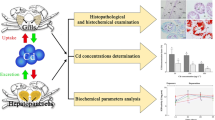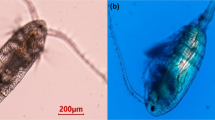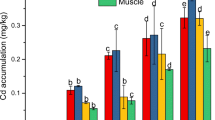Abstract
The vulnerability of aquatic ecosystems due to the entry of cadmium (Cd) is a concern of public and environmental health. This work explores the ability of tissues and symbiotic corpuscles of Pomacea canaliculata to concentrate and depurate Cd. From hatching to adulthood (4 months), snails were cultured in reconstituted water, which was a saline solution in ASTM Type I water. Then, adult snails were exposed for 8 weeks (exposure phase) to Cd (5 μg/L) and then returned to reconstituted water for other 8 weeks (depuration phase). Cadmium concentration in the digestive gland, kidney, head/foot and viscera (remaining of the snail body), symbiotic corpuscles, and particulate excreta was determined by electrothermal atomic absorption spectrometry. After exposure, the digestive gland showed the highest concentration of Cd (BCF = 5335). Symbiotic corpuscles bioaccumulated Cd at a concentration higher than that present in the water (BCF = 231 for C symbiotic corpuscles, BCF = 8 for K symbiotic corpuscles). No tissues or symbiotic corpuscles showed a significant change in the Cd levels at different time points of the depuration phase (weeks 8, 9, 10, 12, and 16). The symbiotic depuration through particulate excreta was faster between weeks 8 and 10, and then slower after on. Our findings show that epithelial cells of the digestive gland of P. canaliculata and their symbiotic C corpuscles are sensitive places for the bioindication of Cd in freshwater bodies.


Similar content being viewed by others
References
Adewunmi CO, Becker W, Kuehnast O, Oluwole F, Dörfler G (1996) Accumulation of copper, lead and cadmium in freshwater snails in southwestern Nigeria. Sci Total Environ 193:69–73
Almendros A, Porcel D (1992) Phosphatase activity in the hepatopancreas of Helix aspersa. Comp Biochem Physiol 103:455–460
Andrews EB (1965) The functional anatomy of the gut of the prosobranch gastropod Pomacea canaliculata and of some other pilids. J Zool 145:19–36
Arrighetti F, Ambrosio E, Astiz M, Rodrigues Capítulo A, Lavarías S (2018) Differential response between histological and biochemical biomarkers in the apple snail Pomacea canaliculata (Gasteropoda: Amullariidae) exposed to cypermethrin. Aquat Toxicol 194:140–151
Athawale MS, Reddy SRR (2002) Storage excretion in the Indian apple snail, Pila globosa (Swainson), during aestivation. Indian J Exp Biol 40:1304–1306
Benito D, Niederwanger M, Izagirre U, Dallinger R, Soto M (2017) Successive onset of molecular, cellular and tissue-specific responses in midgut gland of Littorina littorea exposed to sub-lethal cadmium concentrations. Int J Mol Sci 18:1815
Blasco J, Puppo J (1999) Effect of heavy metals (Cu, Cd and Pb) on aspartate and alanine aminotransferase in Ruditapes philippinarum (Mollusca: Bivalvia). Comp Biochem Physiol C 122:253–263
Blindauer CA, Leszczyszyn OI (2010) Metallothioneins: unparalleled diversity in structures and functions for metal ion homeostasis and more. Nat Prod Rep 27:720–741
Burger J, Gochfeld M (2001) On developing bioindicators for human and ecological health. Environ Monit Assess 66:23–46
Campoy-Diaz AD, Arribére MA, Guevara SR, Vega IA (2018) Bioindication of mercury, arsenic and uranium in the apple snail Pomacea canaliculata (Caenogastropoda, Ampullariidae): bioconcentration and depuration in tissues and symbiotic corpuscles. Chemosphere 196:196–205
Castro-Vazquez A, Albrecht EA, Vega IA, Koch E, Gamarra-Luques C (2002) Pigmented corpuscles in the midgut gland of Pomacea canaliculata and other neotropical apple-snails (Prosobranchia, Ampullariidae): a possible symbiotic association. Biocell 26:101–109
Coeurdassier M, De Vaufleury A, Badot P-M (2003) Bioconcentration of cadmium and toxic effects on life-history traits of pond snails (Lymnaea palustris and Lymnaea stagnalis) in laboratory bioassays. Arch Environ Contam Toxicol 45:102–109
Cueto JA, Giraud-Billoud M, Vega IA, Castro-Vazquez A (2011) Haemolymph plasma constituents of the invasive snail Pomacea canaliculata (Caenogastropoda, Architaenioglossa, Ampullariidae). Molluscan Res 31:57–60
Das S, Khangarot BS (2010) Bioaccumulation and toxic effects of cadmium on feeding and growth of an Indian pond snail Lymnaea luteola L. under laboratory conditions. J Hazard Mater 182:763–770
Dellagnola FA, Rodriguez C, Castro-Vazquez A, Vega IA (2019). A multiple comparative study of putative endosymbionts in the three coexisting apple snail species. PeerJ 7:e8125
Deng PY, Shu WS, Lan CY, Liu W (2008) Metal contamination in the sediment pondweed, and snails of a stream receiving effluent from a lead/zinc mine in southern China. Bull Environ Contam Toxicol 81:69–74
Devi CU, Rao KH, Shyamasundari K (1981) Observations on the histology and cytochemistry of the digestive gland in Pila virens (Lamarck) (Mollusca: Gastropoda). Proc Indian Acad Sci (Anim Sci) 90:307–314
Endo G, Narita M, Huang C-C, Silver S (2002) Microbial heavy metal resistance transposons and plasmids: potential use for environmental biotechnology. J Environ Biotechnol 2:71–82
Fagan MJ, Saier MH (1994) P-type ATPases of eukaryotes and bacteria: sequence analyses and construction of phylogenetic trees. J Mol Evol 38:57–99
Fretter V, Graham A (1962) British prosobranch molluscs. Their functional anatomy and ecology. Ray Society, London
Giraud-Billoud M, Vega IA, Rinaldi Tosi ME, Abud MA, Calderón ML, Castro-Vazquez A (2013) Antioxidant and molecular chaperone defenses during estivation and arousal in the south American apple-snail Pomacea canaliculata. J Exp Biol 216:614–622
Giraud-Billoud M, Castro-Vazquez A, Campoy-Diaz AD, Giuffrida PM, Vega IA (2018) Tolerance to hypometabolism and arousal induced by hibernation in the apple snail Pomacea canaliculata (Caenogastropoda, Ampullariidae). Comp Biochem Physiol B 224:129–137
Godoy MS, Castro-Vazquez A, Vega IA (2013) Endosymbiotic and host proteases in the digestive tract of the invasive snail Pomacea canaliculata: diversity, origin and characterization. PLoS One 8:e66689
Gupta SK, Singh J (2011) Evaluation of mollusc as sensitive indicator of heavy metal pollution in aquatic system: a review. IIOAB J 2:49–57
Hayes KA, Burks RL, Castro-Vazquez A, Darby PC, Heras H, Martín PR, Qiu JW, Thiengo S, Vega IA, Wada T, Yusa Y, Burela S, Cadierno MP, Cueto J, Dellagnola F, Dreon M, Frassa M, Giraud-Billoud M, Godoy M, Ituarte S, Koch E, Matsukura K, Pasquevich M, Rodriguez C, Saveanu L, Seuffert M, Strong E, Sun J, Tamburi NE, Tiecher M, Turner R, Valentine-Darby P, Cowie R (2015) Insights from an integrated view of the biology of apple snails (Caenogastropoda: Ampullariidae). Malacologia 58:245–302
Huang F, Peng L, Zhang J, Lin W, Chen S (2018) Cadmium bioaccumulation and antioxidant enzyme activity in hepatopancreas, kidney, and stomach of invasive apple snail Pomacea canaliculata. Environ Sci Pollut Res 25:18682–18692
Hutton M (1983) Sources of cadmium in the environment. Ecotoxicol Environ Saf 7:9–24
Järup L, Åkesson A (2009) Current status of cadmium as an environmental health problem. Toxicol Appl Pharmacol 238:201–208
Jefree RA, Markich SJ, Brown PL (1993) Comparative accumulation of alkaline-earth metals by two freshwater mussel species from the Nepean river, Australia: consistencies and a resolved paradox. Mar Freshw Res 44:609–634
Kader AA, Osman GY, Mohamed AH, Gharieb MM, Ismail NMM, Abdel-motleb A (2016) Bioaccumulation of heavy metals in freshwater snails in relation to lining of water courses in Egypt. J Biosci Appl Res 2:561–573
Koch E, Vega IA, Albrecht EA, Ortega HH, Castro-Vazquez A (2006) A light and electron microscopic study of pigmented corpuscles in the midgut gland and feces of Pomacea canaliculata (Caenogastropoda: Ampullariidae). Veliger 48:17–25
Koch E, Vega IA, Castro-Vazquez A (2017) Evidence for maternal transmission of a putative endosymbiont in the digestive gland of Pomacea canaliculata (Architaenioglossa, Ampullariidae). Biocell 41:59–61
Lane EA, Canty MJ, More SJ (2015) Cadmium exposure and consequence for the health and productivity of farmed ruminants. Res Vet Sci 101:132–139
Maltez HF, Tagle MV, Fernández de la Campa M del R, Sanz-Medel A (2009) Metal–metallothioneins like proteins investigation by heteroatom-tagged proteomics in two different snails as possible sentinel organisms of metal contamination in freshwater ecosystems. Anal Chim Acta 650:234–240.
Marigómez JA, Cajaraville MP, Angulo E (1990) Cellular cadmium distribution in the common winkle, Littorina littorea (L.) determined by X-ray microprobe analysis and histochemistry. Histochemistry 94:191–199
Marigómez I, Soto M, Cajaraville MP, Angulo E, Giamberini L (2002) Cellular and subcellular distribution of metals in molluscs. Microsc Res Tech 56:358–392
Meenakshi VR (1955) The excretory spherioles in the digestive gland of Pila virens. The Journal Animal Morphology and Physiology (Bombay) 3:75–78
Naylor R (1996) Invasions in agriculture: assessing the cost of the golden apple snail in Asia. Ambio 25:443–448
Nentwig W, Bacher S, Kumschick S, Pyšek P, Vilà M (2018) More than ″100 worst″ alien species in Europe. Biol Invasions 20:1611–1621
Rawlings TA, Hayes KA, Cowie RH, Collins TM (2007) The identity, distribution, and impacts of non-native apple snails in the continental United States. BMC Evol Biol 7:97
Roberts TL (2014) Cadmium and phosphorous fertilizers: the issues and the science. Procedia Eng 83:52–59
Rodriguez C, Prieto GI, Vega IA, Castro-Vazquez A (2019) Functional and evolutionary perspectives on gill structures of an obligate air-breathing, aquatic snail. PeerJ 7:e7342
Soto M, Cajaraville MP, Marigómez I (1996) Tissue and cell distribution of copper, zinc and cadmium in the mussel, Mytilus galloprovincialis, determined by autometallography. Tissue Cell 28:557–568
Tamburi NE, Martín PR (2011) Effects of food availability on reproductive output, offspring quality and reproductive efficiency in the apple snail Pomacea canaliculata. Biol Invasions 13:2351
Tessier L, Vaillancourt G, Pazdernik L (1994) Comparative study of the cadmium and mercury kinetics between the short-lived gastropod Viviparus georgianus (lea) and pelecypod Elliptio complanata (Lightfoot), under laboratory conditions. Environ Pollut 85:271–282
Vega IA, Gamarra-Luques C, Koch E, Bussmann LE, Castro-Vazquez A (2005) A study of corpuscular DNA and midgut gland occupancy by putative symbiotic elements in Pomacea canaliculata (Caenogastropoda, Ampullariidae). Symbiosis 39:37–45
Vega IA, Arribére MA, Almonacid AV, Guevara SR, Castro-Vazquez A (2012a) Apple snails and their endosymbionts bioconcentrate heavy metals and uranium from contaminated drinking water. Environ Sci Pollut Res 19:3307–3316
Vega IA, Dellagnola FA, Hurst JA, Godoy MS, Castro-Vazquez A (2012b) A study of chlorophyll-like and phycobilin pigments in the C endosymbiont of the apple-snail Pomacea canaliculata. Biocell 36:47–55
Viarengo A, Palmero S, Zanicchi G, Capelli R, Vaissiere R, Orunesu M (1985) Role of metallothioneins in Cu and Cd accumulation and elimination in the gill and digestive gland cells of Mytilus galloprovincialis lam. Mar Environ Res 16:23–36
Wallace WG, Lee B-G, Luoma SN (2003) Subcellular compartmentalization of Cd and Zn in two bivalves. I. Significance of metal-sensitive fractions (MSF) and biologically detoxified metal (BDM). Mar Ecol Prog Ser 249:183–197
Weissenhorn W (2005) Crystal structure of the endophilin-A1 BAR domain. J Mol Biol 351:653–661
Yusa Y, Wada T (1999) Impact of the introduction of apple snails and their control in Japan. Naga, the ICLARM Quarterly 22:9–13
Acknowledgments
This work was supported by grants from Universidad Nacional de Cuyo (grants RCS05712015 and RCS4142 2019) and Fondo Nacional de Ciencia y Técnica of Argentina (PICT 20131190). We thank Dr. Cristian Rodriguez for careful reading of the manuscript and advice. The funders had no role in study design, data collection, and analysis, decision to publish, or preparation of the manuscript.
Author information
Authors and Affiliations
Contributions
IAV coordinated the experiments. ADCD and IAV designed and conceived the experiments. ADCD and SEC performed all the experiments. RGW and BVC executed the electrothermal atomic absorption spectrometry analysis. IAV contributed reagents/materials/analysis tools. ADCD and IAV contributed to the writing of the manuscript. All authors approved the final version of the manuscript.
Corresponding author
Ethics declarations
Competing interests
The authors declare that they have competing interests.
Additional information
Responsible editor: Philippe Garrigues
Publisher’s note
Springer Nature remains neutral with regard to jurisdictional claims in published maps and institutional affiliations.
Rights and permissions
About this article
Cite this article
Campoy-Diaz, A.D., Escobar-Correas, S., Canizo, B.V. et al. A freshwater symbiosis as sensitive bioindicator of cadmium. Environ Sci Pollut Res 27, 2580–2587 (2020). https://doi.org/10.1007/s11356-019-07082-x
Received:
Accepted:
Published:
Issue Date:
DOI: https://doi.org/10.1007/s11356-019-07082-x




